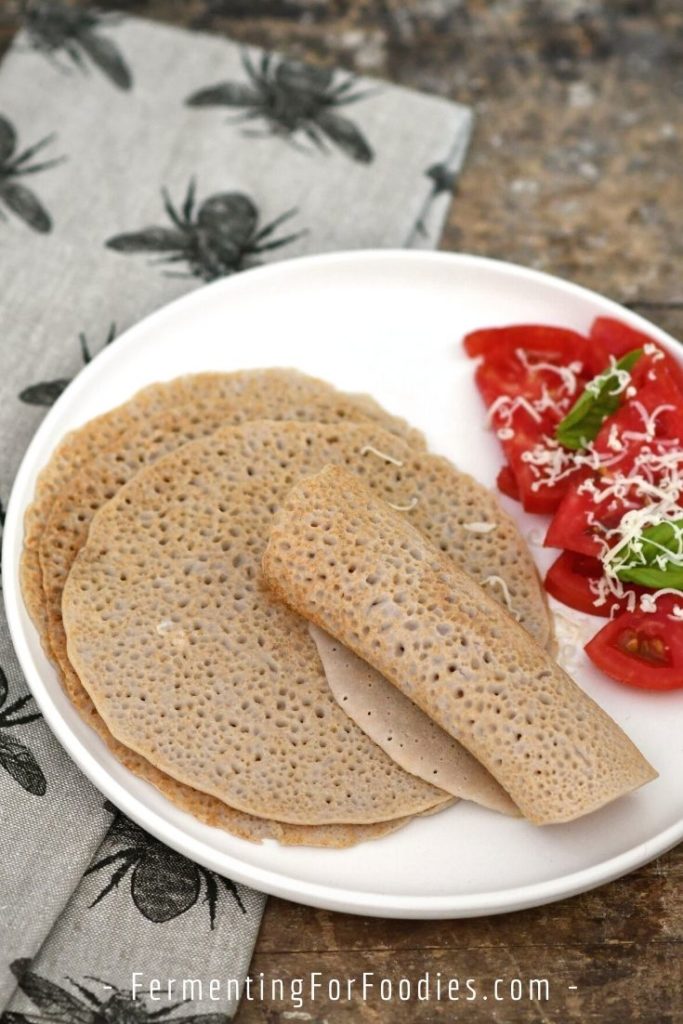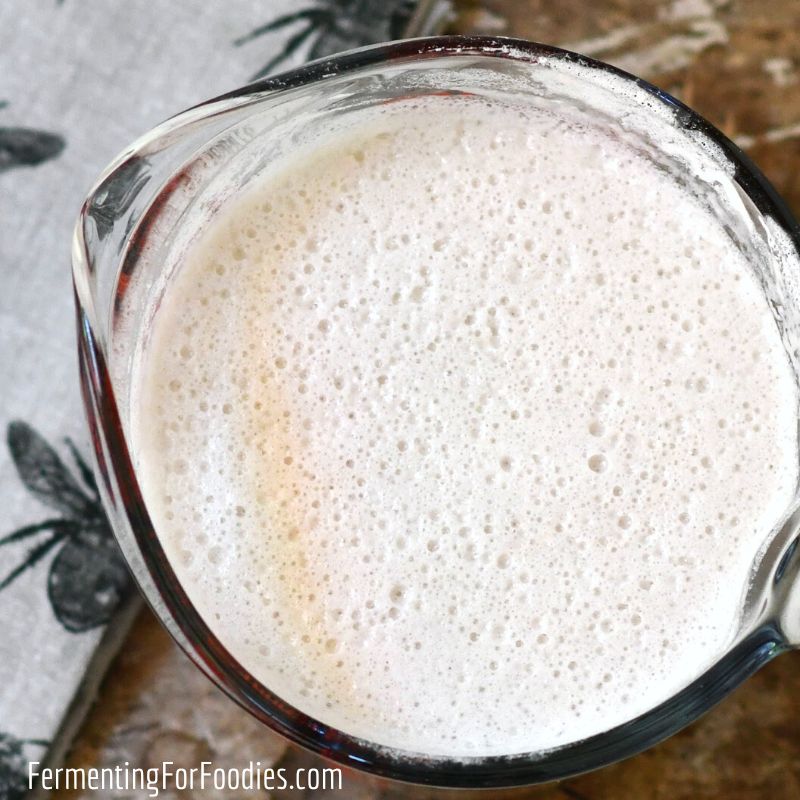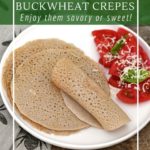This simple recipe for buckwheat crepes uses butter and eggs to give them flavor and stability. It’s the easiest way to make delicious buckwheat crepes.

Crêpes in Brittany
In Brittany, buckwheat crêpes are EVERYWHERE. They’re found in restaurants, at street vendors, and in every supermarket chain. As a gluten-free person traveling in France, they were my go-to meal.
For anyone who is interested, here’s a bit of background:
- In Brittany, 100% buckwheat crêpes are called galettes and are always considered a savory dish.
- Crêpes are made with wheat and are filled with sweet toppings.
So if being gluten-free is important, then be sure to check for authenticity as many of the tourist-focused restaurants will mix a little wheat flour into their galette batter for a more mild-flavored crêpe.
Ask if the crêpe is made with blé (wheat) or sarrasin (buckwheat). To make things even more confusing buckwheat can also be called blé noir (black wheat).
Interested in a few other Brittany-based ferments? Check out my post on lait ribot and chouchen!

Sourdough Ferment
Supermarket galettes are made with just 3 ingredients: salt, water, and buckwheat flour. And a 24-hour sourdough ferment is necessary to get the right flavor.
However, sourdough-based buckwheat crepes also require a well-seasoned nonstick crêpe pan with a special crêpe tool for flipping. And it requires a bit of talent to get the flip the crepe. That’s why many recipes include a bit of wheat flour… Gluten provides the stability necessary to easily flip a crepe.
I don’t have room to store specialized tools in my tiny urban townhouse. And I enjoy the flavor of 100% buckwheat crêpes. So this recipe was created with a great deal of trial and error and involves a bit of butter and eggs. And it is every bit as traditional as a crêpe made without the additional fat.

100% Buckwheat Crepes
Buckwheat crepes are a traditional gluten-free and sourdough fermented recipe! Bring the flavors of Brittany into your kitchen with a simple-to-make homemade crepe.
- Prep Time: 10 minutes
- Cook Time: 20 minutes
- Total Time: 30 minutes
- Yield: Serves 4-5 1x
- Category: Breakfast
- Method: Sourdough
- Cuisine: French
- Diet: Gluten Free
Ingredients
Sourdough Ferment
- 1 cup buckwheat flour
- 1 1/2 cups water (chlorine-free)
Remaining Ingredients
- 1 egg
- 2 Tbsp melted butter
- 1/4 tsp salt
- 1/2 cup of water (as needed)
Instructions
- Mix the flour and water in a glass bowl or measuring cup and leave it somewhere warm to ferment for 12-24 hours. Buckwheat is very quick to catch a sourdough starter, so it won’t take long before it starts to bubble and smell sour. Don’t leave it to ferment for much more than 24 hours or it will taste very sour.
- When you are ready to make the crepes, add in the egg, butter, and salt. Mix well.
- Preheat a cast-iron pan or non-stick pan on medium heat until it is hot.
- Ladle on a small amount of batter (about 1/4 cup). It should be liquidy enough to spread into a thin layer right away. However, you don’t want it too thin or it will be difficult to flip. If necessary add more water (up to 1/2 cup).
- Once the crepe has started to bubble and the middle has begun to dry out, flip the crepe over and allow it to cook for another minute on the other side.
- Fill and serve immediately. Alternatively, crepes can be kept warm in a low (300F) oven.
Notes
- Light buckwheat flour
(like in my photographs) results in a soft crepe with a slightly nutty flavor. Dark buckwheat flour will give your crepes a beautiful purplish shade and an earthy flavor.
- Traditional fillings for buckwheat crepes include cheese, bacon, sausages, and fried eggs. Sweet fillings are also nice. Try chocolate spread with fresh fruit and cultured whipping cream.



These are great! Any idea why these are quick to ferment, while trad white flour takes so much longer?
Thanks! I think it works so well because buckwheat just naturally had a sourdough starter, similar to teff and some other seeds.
We made these this evening. Ferment was 24 hours, then I put the batter in the fridge for a day before we cooked them. They mostly worked well, but we did have one at the beginning and a few at the end that stuck to the pan and ended up falling apart. Very tasty, though! Served them with an egg-tomato-coconut curry and a green bean-cabbage moong dal. We did the 1X batch for 3 of us, made 3 smallish crepes each – might do a bit more next time.
I couldn’t get these to ferment! I left them covered in a glass bowl on the counter for over 24 hours. Any advice?
I used Yupik brand buckwheat flour, it’s a dark variety. Not sure if that makes a difference?
I usually use dark buckwheat (just used light for the photos because it looked nicer). You can still make the crepes even if they haven’t fully fermented. You might be surprised to discover a sourdough flavour anyways. Enjoy!
If I’m using discard from my starter, how much total starter should I use in this recipe?
This recipe is based on a quick, self-starting buckwheat sourdough. After about 24 hours it should be the right sourness. If you want to use discard, then just add a 1/4 cup of discard replacing 2 tbsp of flour and 1/4 cup of water. (Or scale up if you’re making a larger batch). Then only let it ferment for 1 to 2 hours to avoid making really sour tasting crepes. 🙂 Enjoy!
I covered the batter with A rubber banded flour sack towel, then placed in oven with dehydrator heat lid set on 95 degree, since my house was too cold to ferment the last batch. Instead of butter, I used walnut oil. Crepes were amazing! Thank you for the recipe.
Walnut oil sounds delicious!
Yummy, thanks! I didn’t know it was so easy to ferment buckwheat flour. I tried this recipe with a flax egg (vegan) but think it was too runny or I need more flipping practice. Better after I added an additional tablespoon of ground flax.
It is quite a runny batter. However, it sounds like having a slightly bigger flax egg worked. Thanks for sharing!
I found the water to flour ratio to be too high when it comes to the water. The mixture was too watery and I couldn’t save the pancakes.
Hum… I’ve made these a ton of times. It’s actually a favorite recipe. The batter is quite runny… but I wonder if maybe your flour had a different hydration ratio? I’ve made it with both dark and light rye. However, if you used dark rye with more husk than typical it might not absorb as much liquid? Sorry, it didn’t work for you!
Could I use toasted buckwheat groat flour ( kasha)? Will it ferment?
I’m not sure if it will ferment as quickly as the raw flour because the natural yeasts on the buckwheat are likely killed by the toasting. However, it definitely will ferment with kasha flour, using the wild yeasts. It just might take a few extra days. Let me know how it goes! Cheers, Emillie
I haven’t tested this recipe yet, but will 18 hours be enough for fermentation?
Yes, it doesn’t have to be super bubbly or sour. In fact, you may enjoy it more if it’s not too sour! I often do 24 hours, but going a bit short is perfectly fine. Enjoy!
Well, I waited a bit more (27 hours now) but no fermentation seems to have taken place: my starter is still watery and some of the water has evaporated, despite my covering the bowl with a cloth, and it didn’t rise or make bubbles like your picture above. Is it because I should have left it uncovered, or is it the flour I’m using? I’m using the farine de blé noir from Moulin de Rimou (I live in France).
I’m sorry that you’re having trouble. I don’t know that brand (I’m in Canada), however, I’m guessing it’s dark buckwheat flour? That might be why it’s watery because the hulls on the buckwheat won’t absorb as much water as the grain. However, it doesn’t necessarily mean it hasn’t fermented. You just won’t see bubbles on top if it’s too watery.
Does it smell sour? If so, then it’s fermented! Otherwise, covering it with a tea towel won’t prevent microscopic yeasts from getting into the mixture. I googled the brand and it looks great (love the sewn bags!). So my only other thoughts as to what could be going on are regarding your indoor air. If you have a Hepa filter, that removes all wild yeasts from the air. Air pollution can also cause issues with fermentation. If this is your first time fermenting something that can make it slower (as you won’t already have a lot of wild yeasts in your indoor air).
At this point, you probably should try making the crepes and test the flavor. It’s probably the best way to tell if it’s soured. Cheers, Emillie
I finally did them this morning, I guess the batter smelled a little bit sour. On the other hand my crepes were fragile and their texture didn’t allow me to roll them because they kept cracking. I suppose I’ll try with light buckwheat flour next time. Is that why you can roll your crepes like the picture above?
As for the filling, have you ever tried a mix of dried coconut, butter and honey? That’s what my mom used to do for normal crepes when I was a child, and it totally made up for the failure of my crepes xD
Also, have you ever tried making fermented crepes with other flours, like rice flour or potato starch? Or maybe even fermenting the batter with kefir?
If your flour is very dark, you may just need to add a bit more to thicken the batter. It needs to be thin, but not too thin. I’ve dark buckwheat a number of times, and light is definitely easier… which is why I used it for the photos. 🙂 I have a few different crepe-like recipes, but I haven’t tried a kefir crepe! It would probably work as good as waiting for the sourdough to catch. I do have a favorite crepe, socca, which is on my other blog: https://berriesandbarnacles.com/socca-with-wilted-greens-and-emmental/ It’s made with chickpea flour and is definitely savory, not sweet.
Coconut, butter, and honey filling sounds delicious. I’ll try that out the next time we make these!
Cheers, Emillie